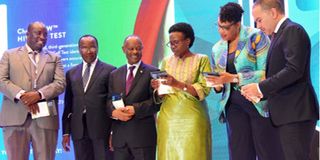Ugandan government unveils easy HIV self-test kit for students

Left to right: Incident manager, Emergency Preparedness and Response cluster lead at the WHO Uganda, Dr Charles Njuguwa; Program Manager for AIDs Control, Dr Joshua Musinguzi; Director General of Health Services, Dr Henry Mwebesa; Health minister Dr Jane Ruth Aceng; US Ambassador Natalie Brown; and Abbott representative Bassem Bibi, during the launch of the Check Now self-testing kit in Kampala yesterday. PHOTO | MONITOR
What you need to know:
- Uganda's Health Minister, Dr Jane Ruth Aceng, who officiated at the launch of the self-test kit at Serena Hotel in Kampala, yesterday said the innovation is being piloted in eight universities, among students between 20 and 34 years
The Ugandan government through the Ministry of Health, has unveiled the Check Now HIV self-test kit to facilitate easy access to testing services among university students.
Dr Jane Ruth Aceng, who officiated at the launch of the self-test kit at Serena Hotel in Kampala, yesterday said the innovation is being piloted in eight universities, among students between 20 and 34 years.
The institutions include Makarere University, Uganda Christian University, Makerere Business School, Kyambogo University, Nkumba University, Kampala International University, Ndejje University, and Nkozi University.
Dr Aceng said once the product is procured in large quantities, other people in the community, including people living with HIV/Aids will have the kits.
“What is available is a donation. We have been negotiating the price with Abbott and subsequently, our partners like the Global Fund of President’s Emergency Plan for AIDS Relief (PEFFA), will procure it for use in Uganda. There are few kits available in the country and will be distributed to those in need,” she said.
Dr Joshua Musinguzi, the programme manager for Aids control , said although their data shows that progress had been made in HIV testing, they still have some gaps among men, children and adolescents.
He revealed that a 2020 study indicated that about 20 percent people, who were living with HIV, had not yet been identified.
“By that time, 80 percent of people living with HIV had been identified. It must have been improved to over 90 percent. Our national target is to reach 90 percent by 2023, and the United Nations Programme on HIV/Aids (Unaids) target is by 2025. We want to fast-track HIV testing, improve treatment, and viral suppression by 2023. HIV care coverage is at 96 percent, viral suppression is about 92 percent,’’ Dr Musinguzi said.
Dr Charles Njuguna, the incident manager, Emergency Preparedness and Response (EPR) cluster lead at the World Health Organisation (WHO) Uganda, encouraged Ugandans to stick to prevention measures to minimise the risk of transmission.
“Abstain from sex or stick to one partner. The risk of HIV is still there,” Dr Njuguna, who represented the WHO country representative, Dr Yonas Tegegn, said.
The United States Ambassador to Uganda, Ms Natalie E. Brown, said her government through initiatives such as PEPFA would continue partnering with Uganda to ensure the population accesses the health services they need.
Abott’s Divisional Vice President for Eastern Europe, Middle East and Africa and Global Accounts, Mr Bassem Bibi, said similar kits had been supplied in other African countries, including South Africa, Nigeria, and Cameroon.
About 1.4 people in Uganda are living with HIV/Aids. The national prevalence rate stands at 5.5 percent. In 2022, a total of 54,000 people contracted HIV/Aids while 18,000 succumbed to the disease.
Steps for self-test
Before testing, you must read all the instructions. Conformance with the test procedure is necessary to ensure an accurate result.
• Prepare a timer and a tissue.
• Open and place all the materials on a flat and clean surface with bright light.
• Wash hands in warm water and dry. If no warm water is available, rub your hands together.
• Choose the ring finger of the middle finger.
• Massage and rub your hands and finger to increase circulation.
• Clean the finger with an alcohol pad. Let it dry for 10 seconds.
• Remove the lancet cover.
• Press the Lancet against the figure until it clicks.
• Massage from the base to the tip, and let two drops of the blood fall onto the basin. If you are having difficulty, wipe the finger clean and squeeze again.
• Wipe your finger with an alcohol pad and apply the plaster. If needed, press on the plaster to stop bleeding. Start the next step immediately to transfer blood.
• Squeeze the top of the spacemen dropper all the way down and hold while dipping into the blood sample.
• Dip the dropper into the blood in Basin and release slowly to draw blood into the dropper. Avoid bubbles when drawing blood.
• Place the dropper over the well labeled squeeze the top of the dropper to apply 1 drop of blood into the wells.
• Start the timer. Read results in 15 to 20 minutes, not past 20 minutes.
Results
If you are negative, a red line will appear in the C area, it means the test did not detect the presence of HIV. However, very recent exposure cannot be excluded.
It is recommended to conduct a retest after six weeks from the latest risk of exposure to HIV.
If you are positive, one line in the C area, together with one line in the T area, no matter how faint, indicates the potential to be HIV positive. Consult a care provider. A reactive test must be confirmed by a lab test. The launch of the self-testing now targets youth in higher institutions of learning.





